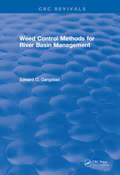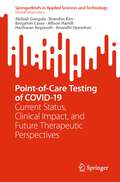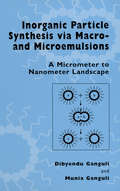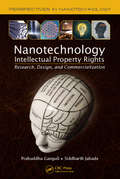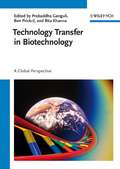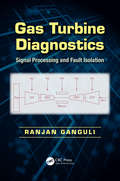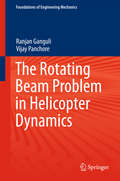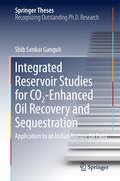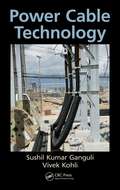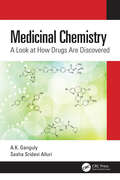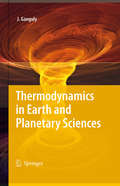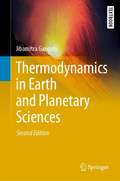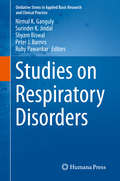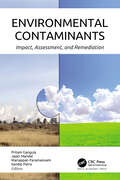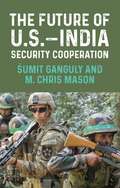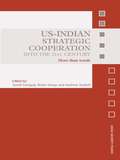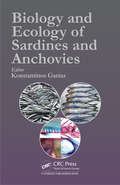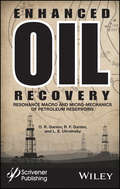- Table View
- List View
Weed Control Methods for River Basin Management
by E.O. GangstadAquatic plants continue to create problems associated with navigation, flood control, agriculture, irrigation and drainage, values of lands, conservation of wildlife and fisheries, and water resource supply. While much research is being done to find more effective and economic control measures, there is now a great need to apply known facts to achieve a measure of control by the means available. It is the purpose of this volume to provide a scientifically documented treatise of the known facts as they apply to the control of aquatic weeds in river basins and their allied waterways with particular emphasis on alligator weed and water hyacinth.
Weed Control Methods for River Basin Management
by E.O. GangstadAquatic plants continue to create problems associated with navigation, flood control, agriculture, irrigation and drainage, values of lands, conservation of wildlife and fisheries, and water resource supply. While much research is being done to find more effective and economic control measures, there is now a great need to apply known facts to achieve a measure of control by the means available. It is the purpose of this volume to provide a scientifically documented treatise of the known facts as they apply to the control of aquatic weeds in river basins and their allied waterways with particular emphasis on alligator weed and water hyacinth.
Point-of-Care Testing of COVID-19: Current Status, Clinical Impact, and Future Therapeutic Perspectives (SpringerBriefs in Applied Sciences and Technology)
by Abilash Gangula Brandon Kim Benjamin Casey Allison Hamill Hariharan Regunath Anandhi UpendranThis book highlights the role of point-of-care (POC) testing in the effective management of the coronavirus disease 2019 (COVID-19) pandemic with an in-depth focus on the recent developments in the field, existing gaps, and future directions. POC tests are of utmost importance as they facilitate rapid and decentralized testing without much instrumentation and technical expertise. The book describes the current status of POC COVID-19 testing in three broad categories: Molecular, antigen, and antibody. The advantages, limitations, and adaption of each of the POC tests are reviewed while highlighting their clinical impact in real-world settings. The role of POC testing for COVID-19 screening, diagnosis, and surveillance has been emphasized. The subtle difference between POC and at-home tests is discussed while elaborating on the necessity for the latter for enhancing clinical impacts. A spotlight on the influence of variants on the performance of POC-COVID-19 tests is provided. The consideration of clinical implications of POC testing in hospitals with regards to improving therapeutic options, patient flow, enhancing the infection control measures, and early recruitment of patients into clinical trials is explained. Finally, the future perspectives that will aid the research community in the development of POC tests for COVID-19 or any infectious disease, in general, are presented. Overall, we believe this book can benefit the research community as it (i) presents a comprehensive understanding of current COVID-19 POC testing methods (ii) highlights features required to transform the current tests developed during the past year as POC diagnostics, and (iii) provides insights to address the unmet challenges in the field.
Inorganic Particle Synthesis via Macro and Microemulsions: A Micrometer to Nanometer Landscape
by Dibyendu Ganguli Munia Ganguli"Nanotechnology" is now very well known as one of the most important key technologies in science and industry. In the field of material science and engineering, nanoparticles should be unit materials, as well as atoms and molecules, to build ceramics, devices, catalysts, and machines, and the "nanoparticle technology" is thus attracting. This novel technology includes various methodologies for nanoparticles: preparation, surface-modification via chemical and/or physical treatments, immobilization and arrangement on supports or substrates, to achieve high performance for luminescence properties in light emitting devices, and high efficiency for catalytic and photocatalytic reactions in chemical synthesis, chemical decomposition, and artificial photosynthesis, etc. It should be needless to say that the preparation of nanoparticles, having precisely controlled particle size, size distribution, chemical composition, and surface properties, is essentially important to realize "true nanoparticle technology". This book, written by Dr. Dibyendu Ganguli and Dr. Munia Ganguli, deals with the preparation methodologies for inorganic nanoparticles using macro- and microemulsions as "microreactor". There are several differences between these two emulsions, in addition to water droplet size: thermodynamic stability, and fusion-redispersion dynamics of the droplets. The properties of the nanoparticles prepared in these emulsion systems are seriously influenced and controlled by the selection of dynamic and static conditions.
Nanotechnology Intellectual Property Rights: Research, Design, and Commercialization (Perspectives in Nanotechnology)
by Prabuddha Ganguli Siddharth Jabade"We need to seamlessly integrate IPR in the standard graduate/post graduate courses in science, technology, commerce, creative arts, etc., without over burdening the students with law"—Dr Prabuddha Ganguli, CEO, VISION-IPRNanotechnology Intellectual Property Rights: Research, Design, and Commercialization offers an overview of the dynamics of development and commercialization in nanotech, where strategic integration of IP, R&D, and commercialization has become imperative. It demystifies issues of intellectual property rights (IPR) associated with research, design, technology transfer, and commercialization of innovations in technology-led areas such as nanotech. Gives all stakeholders vital information to instill confidence by helping them better understand their individual roles in the IPR process Designed for a diverse readership that may not have background knowledge of the legal nuances of IPR, this book clearly articulates techno-legal aspects of nano-related innovations to aid their effective integration into businesses. This resource stands apart by using numerous case studies and pictorial illustrations, addressing aspects ranging from ideation to commercialization of IP-enabled nanotechnology. It illustrates the evolving patent landscape in nanotechnology, explores the international patent classification system, and details patenting procedures in a range of jurisdictions, including search for nanotechnology prior art and creation of search strategies. The authors discuss patent-led nanotechnology businesses, presenting a wide range of case studies that address construction of valuable patent portfolios, growth of start-ups, and consolidation of IP-led nanobusinesses through mergers, acquisitions, joint ventures, strategic investments, etc. They also cover patent litigations in nanotechnologies and the significance of strategically crafting agreements related to IP transactions. In addition, they address compliance with contractual obligations, the importance of well-drafted patent specifications, and sensitive aspects of conducting techno-legal due diligence prior to the development and marketing of products. Also covered are vulnerabilities in challenging/defending the validity of patents and negotiating settlements. Integrating use of the IPRinternalise® model for capacity building in human and infrastructural resources, the authors assess the future of IP landscaping in nanotechnology. Here, they focus on patentability, public perception of risks to health and ecosystems, institutionalized management of intellectual property rights, and the steps that will be necessary to meet these and other such challenges on the way to realizing profits in nanotech.
Nanotechnology Intellectual Property Rights: Research, Design, and Commercialization (Perspectives in Nanotechnology #8)
by Prabuddha Ganguli Siddharth Jabade"We need to seamlessly integrate IPR in the standard graduate/post graduate courses in science, technology, commerce, creative arts, etc., without over burdening the students with law"—Dr Prabuddha Ganguli, CEO, VISION-IPRNanotechnology Intellectual Property Rights: Research, Design, and Commercialization offers an overview of the dynamics of development and commercialization in nanotech, where strategic integration of IP, R&D, and commercialization has become imperative. It demystifies issues of intellectual property rights (IPR) associated with research, design, technology transfer, and commercialization of innovations in technology-led areas such as nanotech. Gives all stakeholders vital information to instill confidence by helping them better understand their individual roles in the IPR process Designed for a diverse readership that may not have background knowledge of the legal nuances of IPR, this book clearly articulates techno-legal aspects of nano-related innovations to aid their effective integration into businesses. This resource stands apart by using numerous case studies and pictorial illustrations, addressing aspects ranging from ideation to commercialization of IP-enabled nanotechnology. It illustrates the evolving patent landscape in nanotechnology, explores the international patent classification system, and details patenting procedures in a range of jurisdictions, including search for nanotechnology prior art and creation of search strategies. The authors discuss patent-led nanotechnology businesses, presenting a wide range of case studies that address construction of valuable patent portfolios, growth of start-ups, and consolidation of IP-led nanobusinesses through mergers, acquisitions, joint ventures, strategic investments, etc. They also cover patent litigations in nanotechnologies and the significance of strategically crafting agreements related to IP transactions. In addition, they address compliance with contractual obligations, the importance of well-drafted patent specifications, and sensitive aspects of conducting techno-legal due diligence prior to the development and marketing of products. Also covered are vulnerabilities in challenging/defending the validity of patents and negotiating settlements. Integrating use of the IPRinternalise® model for capacity building in human and infrastructural resources, the authors assess the future of IP landscaping in nanotechnology. Here, they focus on patentability, public perception of risks to health and ecosystems, institutionalized management of intellectual property rights, and the steps that will be necessary to meet these and other such challenges on the way to realizing profits in nanotech.
Technology Transfer in Biotechnology: A Global Perspective
by Prabuddha Ganguli Ben Prickril Rita KhannaHere, the world's top experts impart their knowledge and experience, many in print for the first time. By considering developing country markets, this book is the first truly global guide to technology transfer, helping companies all around the world to avoid costly mistakes in product development and to recover investments quickly. Individual sections treat trade-related aspects of intellectual property rights, technology transfer in health and healthcare as well as in agriculture and the environment.
Gas Turbine Diagnostics: Signal Processing and Fault Isolation
by Ranjan GanguliWidely used for power generation, gas turbine engines are susceptible to faults due to the harsh working environment. Most engine problems are preceded by a sharp change in measurement deviations compared to a baseline engine, but the trend data of these deviations over time are contaminated with noise and non-Gaussian outliers. Gas Turbine Diagnos
The Rotating Beam Problem in Helicopter Dynamics (Foundations of Engineering Mechanics)
by Ranjan Ganguli Vijay PanchoreThe book addresses computational methods for solving the problem of vibration, response, loads and stability of a helicopter rotor blade modeled as a rotating beam with flap or out-of-plane bending. The focus is on explaining the implementation of the finite element method in the space and time domain for the free vibration, aeroelastic response and stability problems. The use of Floquet analysis for the aeroelastic stability analysis of rotor blades is also shown. The contents of the book will be useful to researchers in aerodynamics and applied mechanics, and will also serve well professionals working in the aerospace industry.
Integrated Reservoir Studies for CO2-Enhanced Oil Recovery and Sequestration: Application to an Indian Mature Oil Field (Springer Theses)
by Shib Sankar GanguliThis book addresses the feasibility of CO2-EOR and sequestration in a mature Indian oil field, pursuing for the first time a cross-disciplinary approach that combines the results from reservoir modeling and flow simulation, rock physics modeling, geomechanics, and time-lapse (4D) seismic monitoring study. The key findings presented indicate that the field under study holds great potential for enhanced oil recovery (EOR) and subsequent CO2 storage. Experts around the globe argue that storing CO2 by means of enhanced oil recovery (EOR) could support climate change mitigation by reducing the amount of CO2 emissions in the atmosphere by ca. 20%. CO2-EOR and sequestration is a cutting-edge and emerging field of research in India, and there is an urgent need to assess Indian hydrocarbon reservoirs for the feasibility of CO2-EOR and storage. Combining the fundamentals of the technique with concrete examples, the book is essential reading for all researchers, students and oil & gas professionals who want to fully understand CO2-EOR and its geologic sequestration process in mature oil fields.
Power Cable Technology
by Sushil Kumar Ganguli Vivek KohliPower Cable Technology provides a precise understanding of the design, manufacture, installation, and testing of a range of electric power cables—from low-voltage, 1,000/1,100V cables to extra-high-voltage, 400kV cables—with reference to future trends in the industry. The authors’ mantra is: know your cable. Thus, the book begins with a comprehensive overview of power cable design and manufacturing through the ages, and then: Describes the characteristics of the materials currently used in the production of various power cables Explains how to calculate the die orifice for drawing wires, how tolerance in manufacturing affects material weight and consumption, and how and why lubricants are used Addresses the formation, stranding, and insulation of the electrical conductors, as well as the sheathing, armouring, and protective covering of the power cables Delivers an in-depth discussion of quality systems, quality control, and performance testing Covers the many nuances of cable installation, including laying, jointing, and terminating Throughout, the authors emphasise consonance between design theory and practical application to ensure production of a quality power cable at a reasonable cost. They also underscore the importance of careful handling, making Power Cable Technology a must read for power cable engineers and technicians alike.
Power Cable Technology
by Sushil Kumar Ganguli Vivek KohliPower Cable Technology provides a precise understanding of the design, manufacture, installation, and testing of a range of electric power cables—from low-voltage, 1,000/1,100V cables to extra-high-voltage, 400kV cables—with reference to future trends in the industry. The authors’ mantra is: know your cable. Thus, the book begins with a comprehensive overview of power cable design and manufacturing through the ages, and then: Describes the characteristics of the materials currently used in the production of various power cables Explains how to calculate the die orifice for drawing wires, how tolerance in manufacturing affects material weight and consumption, and how and why lubricants are used Addresses the formation, stranding, and insulation of the electrical conductors, as well as the sheathing, armouring, and protective covering of the power cables Delivers an in-depth discussion of quality systems, quality control, and performance testing Covers the many nuances of cable installation, including laying, jointing, and terminating Throughout, the authors emphasise consonance between design theory and practical application to ensure production of a quality power cable at a reasonable cost. They also underscore the importance of careful handling, making Power Cable Technology a must read for power cable engineers and technicians alike.
Medicinal Chemistry: A Look at How Drugs Are Discovered
by A.K. Ganguly Sesha Sridevi AlluriMedicinal Chemistry: A Look at How Drugs Are Discovered is written for those who are interested in learning how drugs are discovered. Compared to other books on the market, this text takes a different approach by presenting the subject on chemical reaction mechanism terms, which ideally makes the subject matter more interesting and easier to comprehend. The authors describe the drug discovery process, from advancing an initial lead to the approval process, and include drug discovery sources. Additional features: Explains medicinal chemistry on chemical mechanism terms, allowing for a more interesting and easier to comprehend text Includes valuable insights toward the various pathways taken at pharmaceutical industries in drug discoveries Improved by including questions raised and suggestions made from students in the authors’ medicinal chemistry classes This book will benefit both upper level undergraduates and graduates studying in the fields of medicinal chemistry and drug discovery, as well as scientists working in the pharmaceutical industry.
Medicinal Chemistry: A Look at How Drugs Are Discovered
by A.K. Ganguly Sesha Sridevi AlluriMedicinal Chemistry: A Look at How Drugs Are Discovered is written for those who are interested in learning how drugs are discovered. Compared to other books on the market, this text takes a different approach by presenting the subject on chemical reaction mechanism terms, which ideally makes the subject matter more interesting and easier to comprehend. The authors describe the drug discovery process, from advancing an initial lead to the approval process, and include drug discovery sources. Additional features: Explains medicinal chemistry on chemical mechanism terms, allowing for a more interesting and easier to comprehend text Includes valuable insights toward the various pathways taken at pharmaceutical industries in drug discoveries Improved by including questions raised and suggestions made from students in the authors’ medicinal chemistry classes This book will benefit both upper level undergraduates and graduates studying in the fields of medicinal chemistry and drug discovery, as well as scientists working in the pharmaceutical industry.
Thermodynamics in Earth and Planetary Sciences
by Jibamitra GangulyBased on a university course, this book provides an exposition of a large spectrum of geological, geochemical and geophysical problems that are amenable to thermodynamic analysis. It also includes selected problems in planetary sciences, relationships between thermodynamics and microscopic properties, particle size effects, methods of approximation of thermodynamic properties of minerals, and some kinetic ramifications of entropy production. The textbook will enable graduate students and researchers alike to develop an appreciation of the fundamental principles of thermodynamics, and their wide ranging applications to natural processes and systems.
Thermodynamics in Earth and Planetary Sciences (Springer Textbooks in Earth Sciences, Geography and Environment)
by Jibamitra GangulyBased on a university course, this book provides an exposition of a large spectrum of geological, geochemical and geophysical problems that are amenable to thermodynamic analysis. It also includes selected problems in planetary sciences, relationships between thermodynamics and microscopic properties, particle size effects, methods of approximation of thermodynamic properties of minerals, and some kinetic ramifications of entropy production. The textbook will enable graduate students and researchers alike to develop an appreciation of the fundamental principles of thermodynamics, and their wide ranging applications to natural processes and systems.
Studies on Respiratory Disorders (Oxidative Stress in Applied Basic Research and Clinical Practice)
by Nirmal K. Ganguly Surinder K. Jindal Shyam Biswal Peter J. Barnes Ruby PawankarThis volume covers data describing the role of free radicals and antioxidants in respiratory disorders, including the data that deal with clinical and pre-clinical trials. Chapters describe the relationship of oxidative stress to a number of respiratory and pulmonary conditions from a basic science and clinical perspective, including chronic obstructive pulmonary disease, asthma, acute lung injury, pulmonary hypertension, toxicity and fibrosis, cancer and asbestosis. The book also discusses the use of conventional biomarkers of oxidative stress and breath condensates as adjuncts to classical laboratory testing, the effect of antioxidants on cellular protection, as well as the development of novel antioxidant modalities.
Environmental Contaminants: Impact, Assessment, and Remediation
by Pritam Ganguly Jajati Mandal Mariappan Paramasivam Sandip PatraThis new volume looks at the impact, assessment, and remediation of various environmental contaminants. It discusses the environmental changes that can occur due to arsenic, heavy metals, herbicides, fluorides, microplastics, chemical fertilizers contaminants; the remedial measures of these environmental contaminants; and how to analyze trace-level concentrations of contaminants.
The future of U.S.–India security cooperation
by Sumit Ganguly M. Chris MasonThis book deals with the evolution, current status and potential of U.S.-India strategic cooperation. From very modest beginnings, the U.S.-India strategic partnership has developed significantly over the last decade. In considerable part, this growth has stemmed from overlapping concerns about the rise and assertiveness of the People’s Republic of China, as well as the instability of Pakistan. Despite the emergence of this partnership, significant differences remain, some of which stem from Cold War legacies, others from divergent global strategic interests and institutional design. In spite of these areas of discord, the overall trajectory of the relationship appears promising. Increased cooperation and closer policy coordination underscore a deepening of the relationship, while fundamental differences in national approaches to strategic challenges demand flexibility and compromise in the future.
US-Indian Strategic Cooperation into the 21st Century: More than Words (Asian Security Studies)
by Sumit Ganguly Andrew Scobell Brian ShoupIn this edited book, leading scholars and analysts trace the origins, evolution and the current state of Indo-US strategic cooperation. During the Cold War, owing to opposing grand strategies, the two states frequently found themselves at odds. With the end of the Cold War and the demise of the Soviet Union, Indo-US security cooperation started in a fitful fashion, but in recent years it has acquired considerable stability. The armed forces of the two states have participated in exercises on land, sea and air and have also carried out joint humanitarian missions. Drawing on new information and with contributions from both academics and policy makers, this wide-ranging volume analyzes the strategic convergence of the world’s two largest democracies, whilst explaining why important differences do remain. These notably include questions pertaining to the future of India’s nuclear and ballistic missile programs, US-Pakistan ties and India’s links with Iran. This volume will be of great interest to students of South Asian politics, Asian security, US foreign policy and security studies in general.
US-Indian Strategic Cooperation into the 21st Century: More than Words (Asian Security Studies)
by Sumit Ganguly Brian Shoup Andrew ScobellIn this edited book, leading scholars and analysts trace the origins, evolution and the current state of Indo-US strategic cooperation. During the Cold War, owing to opposing grand strategies, the two states frequently found themselves at odds. With the end of the Cold War and the demise of the Soviet Union, Indo-US security cooperation started in a fitful fashion, but in recent years it has acquired considerable stability. The armed forces of the two states have participated in exercises on land, sea and air and have also carried out joint humanitarian missions. Drawing on new information and with contributions from both academics and policy makers, this wide-ranging volume analyzes the strategic convergence of the world’s two largest democracies, whilst explaining why important differences do remain. These notably include questions pertaining to the future of India’s nuclear and ballistic missile programs, US-Pakistan ties and India’s links with Iran. This volume will be of great interest to students of South Asian politics, Asian security, US foreign policy and security studies in general.
Biology and Ecology of Sardines and Anchovies
by Konstantinos GaniasApart from being commercially and socially significant, anchovies and sardines populations occupy crucial positions in the oceans' ecosystems. Low in the food chain, clupeoids tend towards abundance, as if their purpose in life was to be eaten and fuel the upper levels of marine trophic chains. The present book covers a broad spectrum of topics on
Evangelicalism and Conflict in Northern Ireland (Contemporary Anthropology of Religion)
by G. GanielThis innovative book explores the role of evangelical religion in the conflict in Northern Ireland, including how it may contribute to a peaceful political transition. Ganiel offers an original perspective on the role of a 'strong' religion in conflict transformation, and the misunderstood role of evangelicalism in the process.
Enhanced Oil Recovery: Resonance Macro- and Micro-Mechanics of Petroleum Reservoirs
by O. R. Ganiev R. F. Ganiev L. E. UkrainskyFossil fuels, especially petroleum, are still the primary energy source all over the world. With the advent of hydraulic fracturing (i.e. "fracking"), directional drilling, and other technological advances, petroleum and reservoir engineers all over the world have been able to produce much greater results, in much more difficult areas, than ever before, to meet higher global demand. "Enhanced oil recovery (EOR)" is one of the hottest and most important topics in this industry. New technologies and processes must be continually discovered and developed, even as renewable energy begins to grow and become more fruitful, as the demand for more and more energy continues to grow worldwide. This groundbreaking and highly anticipated study discusses the scientific fundamentals of resonance macro- and micro-mechanics of petroleum reservoirs and its petroleum industry applications. It contains an overview of the research and engineering results of resonance macro- and micro-mechanics of petroleum reservoirs, which provide the scientific and applied foundations for the creation of groundbreaking wave technologies for production stimulation and enhanced oil recovery. A valuable tool for the petroleum or reservoir engineer in the field, this volume is also intended for students, teachers, scientists and practitioners who are interested in the fundamentals, development, and application of leading-edge technologies in the petroleum industry and other industrial sectors.
Enhanced Oil Recovery: Resonance Macro- and Micro-Mechanics of Petroleum Reservoirs
by O. R. Ganiev R. F. Ganiev L. E. UkrainskyFossil fuels, especially petroleum, are still the primary energy source all over the world. With the advent of hydraulic fracturing (i.e. "fracking"), directional drilling, and other technological advances, petroleum and reservoir engineers all over the world have been able to produce much greater results, in much more difficult areas, than ever before, to meet higher global demand. "Enhanced oil recovery (EOR)" is one of the hottest and most important topics in this industry. New technologies and processes must be continually discovered and developed, even as renewable energy begins to grow and become more fruitful, as the demand for more and more energy continues to grow worldwide. This groundbreaking and highly anticipated study discusses the scientific fundamentals of resonance macro- and micro-mechanics of petroleum reservoirs and its petroleum industry applications. It contains an overview of the research and engineering results of resonance macro- and micro-mechanics of petroleum reservoirs, which provide the scientific and applied foundations for the creation of groundbreaking wave technologies for production stimulation and enhanced oil recovery. A valuable tool for the petroleum or reservoir engineer in the field, this volume is also intended for students, teachers, scientists and practitioners who are interested in the fundamentals, development, and application of leading-edge technologies in the petroleum industry and other industrial sectors.
